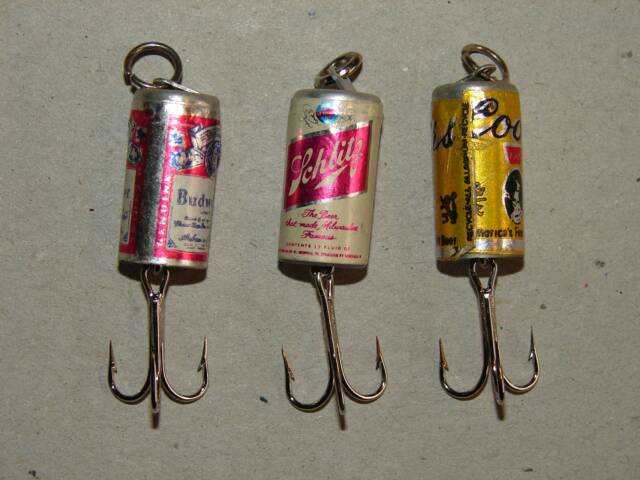







Check That Tacklebox
Enter your text here...
Look in your tackle box, way at the bottom. Yep, there it is. That fishing lure you got from your dad that you were so proud of as a kid. But, even though it was “cool looking”…it turns out he gave it to you for he could not catch anything on it. And neither can you.
Before you junk that “can’t catch anything on it” lure to make room for this year's red-hot lure, check with a lure collector. Maybe it is not worth anything…but maybe it is just what a lure collector is looking for. The statement “Someone’s junk is another one’s treasure” holds very true in this case.
Images and other materials contained on this web site are the property of retiredlures.com
and may not be reproduced or used on other web sites or for personal use without our written permission.
Don't be bothered by the fact that fish won't give the lure a second look. The ineffective plugs are the ones collectors want. Bass-Orenos, Rapalas, Lazy Ikes, and Pikie Minnows caught fish and were made by the truckload, so unless they're an odd color or have some other quirk, they're not worth much. But the lures that didn't catch fish weren't mass-produced because they did not sell, so they're scarce and therefore could be valuable. It is true that many lures were meant to catch more fisherman than fish themselves.
Or maybe you have a lure you got from your grandpa. Or, even better, your grandpa’s grandpa. The lure is so well made; it still looks great after nearly 100 years. Due to its age, it may be worth something. Heck, it had to have worked if your relative spent $1.00 for a lure in the early 1900s. That was a lot of money back then! That also explains why many people made their own “folk-art” lures, which can also be collectable.
I started collecting tackle to some extent around the early 1980s. It started when I “retired” a few of my first lures and some I received from my parents. I then started purchasing lures at garage sales and auctions and back then, the stuff was cheap. Now, some of it sells for eye-popping prices. Lures can sell in the hundreds and even the thousands of dollars. But don't get your hopes up, that's far from typical.
Several huge factors determine what your lure could be worth. Name of manufacturer, type, color, rarity, age, and condition to name a few. Condition refers to the original condition of the lure. A re-built or re-paint brings the value down lower than even a beat-up lure. The better the original shape of the lure, the more it is worth. The old lost and never-been-fished lures can bring the big bucks. Color can change the demand drastically. A red and white lure may be only worth a few dollars while a blue and gold lure of the same type can be worth hundreds.
Also, the box the lure came in can be collectable. Who saved the boxes…right? Adding a box to a lure can double the value, if not more. Collectors seek old cardboard boxes and wooden slide-boxes which can be worth more than the lure itself. Not only can the box add to a collection, but it can also give us information on the lure and company that made it. Old lure company catalogs, ads and brochures also offer tons of information.
There are many lure collectors out there. Some with lots of knowledge and who “specialize” in certain lures and some that are “pile collectors” with little knowledge of what they have. There are also “collectors” just to make a fast buck by buying a lure cheap and selling it to a true collector for big bucks. People collect rods, reels and other fishing paraphernalia also. But mostly they collect lures. I have many lures in my collection, but also has some other items such as spearing decoys, fish scales (no pun intended), sinker tins, bobbers, and even a classic Popeil Pocket Fisherman. There are several lure books on the market which price lures in very good condition, but even these books can vary greatly on their value of a lure.
Over the years, many people/companies had ideals on how to “make a better mouse trap”. Some innovations were found literally by accident. It is rumored that famous lure inventor James Heddon tossed a carved stick into the lake near his home and witnessed a bass strike it, giving him an idea. Heddon is also rumored to have developed his famed crackle-back lure paint finish due to his “failed” attempt to quick dry some lures in his kitchen oven. J. T. Buel is reported to have accidentally dropped a teaspoon overboard while fishing to inspire his early metal lure patents.
Lure materials have changed. Lures used to have glass eyes, and then tack eyes, and then painted eyes (not always in that order). The earliest lures were made of wood, metal or rubber…for plastic was not invented at the time of manufacture. But, just because it is wood, that doesn’t make it old. Brass hardware on lures was changed to cheaper materials. New innovations to meet fisherman’s demands, such as weedless and mechanical lures, were some of the designs that stormed the market to catch fisherman (as well as fish).
Events changed lures. There was a lawsuit involving hook hardware between two major tackle companies pre-1910 (Shakespeare and Pflueger) that resulted in the changing of their hardware. The state of New Jersey had an early law that stated no lure could have more than three hooks. World War II saw companies such as C.C. Roberts Co change their lures for some of their lure parts were bought from Germany. WWII also saw a change in other lures due to shortages of materials, such as the popular Jitterbug going to a plastic lip instead of their standard metal lip. Some large companies even stopped their lure production in order to manufacture parts for the war effort. Even environmental concerns changed lures. No more lures with mercury or batteries in them and fewer lures with more than 2 or 3 treble hooks. It is tough to catch and release a fish from a lure with six treble hooks (18 barbed hooks) on it! Some lures of the past even had hooks that shoot out deep into the fish’s mouth. There would be no catch-and-release for this unlucky fish. But, back then, you ate what you caught. You never even thought about putting that “big guy” back.
And then along came the discovery of plastics. Now the capability of mass-producing lures of “indestructible” plastic was possible, taking the unique quality out of many lures for more quantity. No more hand painting lures individually (note: mainly women had this task because it was believed their smaller hands made them better painters of lures). At first, many plastic lures were not perfect due to imperfections in the makeup and some have deteriorated over time. But soon plastic ruled the tackle market, which it where it is today.
Other than something to look at, are these old lures of any use? Well, I like the history of the lure as well as the history of the company that made it. And yes, I have fished with some of them. It is a great feeling knowing that a 60 year-old or more lure still works…and works well. For the most part though, my collection is considered to be a “retirement home for lures”. Much of my collection is from friends and family, as well as strangers who sold or gave me lures for they knew I would treasure them…no matter if they worked at catching fish or not. In my quest for lures, I have found some treasures in unique places. I found an old cork frog that was being used by a friend’s grandparent as a Christmas tree ornament for over 60 years. Another friend brought me an old early 1900’s lure that was being used to hold up a curtain in an old storage shed. My luck at finding lures has diminished lately, but I will always be in pursuit of his next find. Lately my fondness for my lures has grown due to the heightened popularity of collecting lures and the increased difficulty of finding a treasure without shelling out huge dollars. After all to me, the real hobby is in the find and the history as well as the lure itself.
So, if you have an interesting lure…let me know. It may be junk…but who knows…you may have something. If not for my collection, I could point you to someone that may be interested.